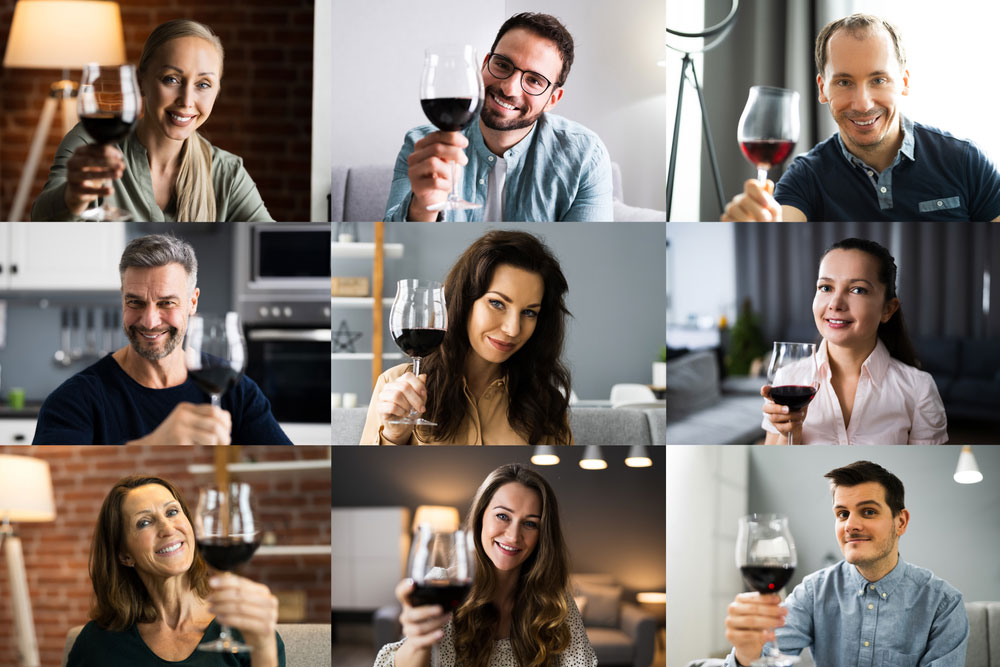Virtual wine tasting is an online experience that allows participants to taste and learn about different wines from the comfort of their own homes. It typically involves a virtual session led by a professional wine expert or sommelier who guides participants through the wine-tasting process, shares information about the wines being tasted, and answers any questions participants may have.
During a virtual wine tasting, participants typically receive a package of wine samples in advance, which they then taste and evaluate during the session. The virtual wine expert may provide guidance on how to taste and evaluate the wines, and may also provide information on the winemaking process, the characteristics of the grapes, and the history and culture of the wine region.
Virtual wine tastings can be conducted using video conferencing software or other online platforms, allowing participants from all over the world to join in and connect with each other over their shared love of wine. They are becoming increasingly popular as a way to bring people together for social events, corporate team-building activities, and educational experiences.
What kind of questions are usually asked?
Here are some sample virtual wine tasting questions that participants might ask
- What grape varieties are used in this wine?
- What is the history of the winery that produced this wine?
- What are the tasting notes for this wine?
- What food pairings would you recommend for this wine?
- What is the alcohol content of this wine?
- What is the ideal temperature to serve this wine?
- What are the winemaking techniques used to produce this wine?
- What is the vintage of this wine?
- What region is this wine from?
- What is the price point for this wine?

Is virtual wine tasting expensive?
The cost of virtual wine tasting can vary depending on several factors, such as the number and quality of wines included in the package, the experience and expertise of the wine expert leading the session, and the duration of the event.
Some virtual wine tastings may be more expensive if they include high-end, rare, or exclusive wines, while others may be more affordable if they feature more accessible or budget-friendly options. Additionally, some virtual wine tastings may include additional elements, such as food pairings, wine accessories, or educational materials, which can also affect the overall cost.
However, virtual wine tastings can often be a more cost-effective option compared to in-person tastings, as they eliminate the need for travel, accommodations, and other expenses associated with attending a physical event. Overall, the cost of virtual wine tasting can range from around $30 to $200 or more per person, depending on the specific event and its offerings.
How do i sign up for virtual wine tasting?
There are several ways to sign up for virtual wine tasting, depending on your preferences and the specific event or company you want to work with. Here are some common steps you can take to sign up for a virtual wine tasting:
- Research virtual wine tasting events or companies: Look for virtual wine tasting events or companies online, through social media, or through referrals from friends or family members. Make sure to read reviews and check their websites for information about pricing, availability, and the types of wines they offer.
- Choose an event or company: Once you have a list of virtual wine tasting options, choose the one that best fits your preferences, budget, and schedule.
- Register or purchase a wine tasting package: Depending on the event or company, you may need to register or purchase a package in advance. This may involve filling out an online form, selecting a specific date and time, or choosing the type and number of wines you want to taste.
- Receive your wine package: Once you have registered or purchased your package, you should receive your wine package in the mail. Make sure to follow any instructions provided by the event or company regarding storage, serving, and preparation.
- Attend the virtual wine tasting: On the day of the virtual wine tasting, make sure you have a computer, tablet, or smartphone with a stable internet connection and access to the video conferencing platform being used for the event. Follow any instructions provided by the wine expert or host, and be prepared to taste, evaluate, and discuss the wines with the other participants.
Overall, the process of signing up for virtual wine tasting can be simple and straightforward, as long as you choose a reputable and well-organized event or company.

Hosting a virtual wine tasting can be a fun and interactive way to explore different wines with friends, family, or colleagues from the comfort of your own homes. Here’s a step-by-step guide on how to host a virtual wine tasting:
Choose a Date and Time: Select a date and time that works for all participants. Consider sending out invitations well in advance, so everyone can plan accordingly.
Select the Wines: Decide on a theme for your wine tasting, such as a specific region, grape variety, or style of wine. Choose a selection of wines that fit the theme, ideally 3-5 different bottles. Make sure the wines are readily available to all participants, or provide suggestions for alternatives that can be found easily.
Send Wine Recommendations and Instructions: Share the list of selected wines with participants ahead of time, along with any specific instructions, such as proper storage, serving temperature, and suggested food pairings. Encourage participants to acquire the wines in advance, allowing them to be prepared for the tasting.
Gather Wine Tasting Supplies: Make sure you have the necessary supplies on hand, such as wine glasses (one for each wine), a corkscrew or wine opener, a notepad and pen for taking notes, and a spittoon or a container for those who prefer to spit or discard the wine instead of consuming it.
Set Up the Virtual Platform: Choose a video conferencing platform that suits your needs, such as Zoom, Microsoft Teams, or Google Meet. Send out the meeting invitation with the appropriate link and instructions for joining the virtual wine tasting.
Create an Agenda: Plan a loose agenda for the virtual wine tasting to ensure a smooth flow. Consider introducing each wine, discussing its background, characteristics, and any interesting facts. Allow time for participants to ask questions and share their thoughts and observations.
Provide Tasting Sheets: Share tasting sheets or templates that participants can use to record their observations. Include sections for appearance, aroma, taste, and overall impressions. This will help guide the discussion and allow participants to compare their experiences.
Conduct the Virtual Wine Tasting: Start the virtual wine tasting by welcoming everyone and briefly introducing the wines and their respective background. Encourage participants to pour a small amount of each wine into their glasses and guide them through the tasting process, discussing the appearance, aromas, flavors, and other relevant characteristics of each wine. Encourage open discussion and engagement among participants.
Explore Food Pairings: Discuss suggested food pairings for each wine and invite participants to share their own food pairing suggestions. This can add an extra layer of enjoyment to the tasting experience.
Enjoy and Socialize: Encourage participants to relax, enjoy the wines, and engage in conversations. Foster a friendly and inclusive atmosphere where everyone feels comfortable sharing their thoughts and experiences.
Remember, the main goal of a virtual wine tasting is to have fun, learn something new, and connect with others over a shared interest in wine. By following these steps and adapting them to your specific needs, you can host a memorable virtual wine tasting experience for yourself and your guests.

Some interesting wine facts:
Oldest Known Winery: The world’s oldest known winery was discovered in Armenia in 2010. The site, called Areni-1, dates back to around 4100 BCE and contained fermentation vessels, grape seeds, and other winemaking equipment.
Varietal vs. Blends: Wine can be made from a single grape variety (varietal) or a blend of multiple grape varieties. Some wines, like Cabernet Sauvignon and Chardonnay, are known for their varietal character, while others, like Bordeaux blends, are crafted by combining different grape varieties.
Terroir: The concept of terroir is central to wine production. It refers to the environmental factors, including soil, climate, topography, and vineyard location, that influence a wine’s characteristics. Terroir plays a crucial role in shaping the flavor, aroma, and quality of the wine.
Wine Colors: Wine comes in various colors, including red, white, rosé, and even orange. The color of the wine is derived from the grape skins during the winemaking process. Red wines are fermented with the grape skins, while white wines are typically made without skin contact.
Sparkling Wine: Sparkling wine is known for its bubbles, which are created through a secondary fermentation process. Champagne is perhaps the most famous sparkling wine, but there are many other sparkling wine styles, such as Prosecco, Cava, and Franciacorta.
Age-Worthy Wines: Some wines have the potential to age and improve over time. Age-worthy wines often have higher acidity, tannins, and complexity. They can develop unique flavors, aromas, and textures as they mature in the bottle.
The Cork vs. Screw Cap Debate: The choice of closure for wine bottles has been a subject of debate. Traditional cork closures allow for gradual oxygen exchange, aiding in the aging process. However, screw caps have gained popularity as a convenient and reliable alternative, particularly for wines meant to be consumed young.
Wine Bottle Sizes: Wine bottles come in various sizes, each with its own name and capacity. The most common bottle size is the standard 750 milliliters, but there are also larger formats, such as magnums (1.5 liters) and Nebuchadnezzars (15 liters).
Health Benefits of Wine: Moderate wine consumption has been associated with potential health benefits. Red wine, in particular, is often praised for its antioxidant properties and potential cardiovascular benefits. However, it’s important to consume wine in moderation and in the context of a balanced lifestyle.
Wine Auctions: Wine auctions are held worldwide, offering collectors and wine enthusiasts the opportunity to acquire rare and valuable bottles. These auctions can reach astronomical prices, with certain wines becoming highly sought after by collectors.
These intriguing wine facts highlight the rich history, diversity, and cultural significance of this beloved beverage. Whether you’re a wine connoisseur or simply enjoy a glass from time to time, exploring the world of wine can be a fascinating journey. Cheers to discovering and savoring the wonders of wine!
